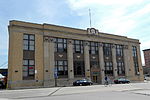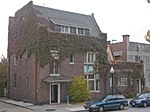Greenmount West, Baltimore

Greenmount West is a neighborhood in the state-designated Station North Arts District of Baltimore City. Its borders consist of Hargrove Alley to the west, Hoffman Street and the Amtrak railroad tracks to the south, the south side of North Avenue to the north, and Greenmount Avenue to the east. Residents in the area include a mix of low, middle and high income families, artists, commuters to Washington DC and working-class Baltimoreans with the majority of residents of African American descent. The neighborhood was one of many affected by the Baltimore riot of 1968. For years, the area suffered from urban decay, housing abandonment and crime, but in recent times the area has experienced a resurgence. Artists have created live/work space in the sprawling former Crown Cork and Seal factory buildings (commonly known as the Copycat Building) along the railroad tracks. Small developers are rehabbing the two and three story rowhouses for market rate homeownership. Pocket parks like McAllister Park, Hunters Lot and Brentwood Commons were created in the area, and the neighborhood's 2002 designation as an Arts and Entertainment District further catalyzed development. The real estate bubble of the 2000s caused Baltimore's housing prices to skyrocket, and drove home buyers seeking out cheaper areas on the upswing to the neighborhood. Housing sales in 2009 ranged between $169,000 - $320,000.
Excerpt from the Wikipedia article Greenmount West, Baltimore (License: CC BY-SA 3.0, Authors, Images).Greenmount West, Baltimore
East Lanvale Street, Baltimore
Geographical coordinates (GPS) Address Nearby Places Show on map
Geographical coordinates (GPS)
| Latitude | Longitude |
|---|---|
| N 39.309166666667 ° | E -76.611388888889 ° |
Address
East Lanvale Street 314
21202 Baltimore
Maryland, United States
Open on Google Maps









